Corporate Accounting: Detailed Financial Statement Analysis Report
VerifiedAdded on 2024/06/03
|11
|2861
|415
Report
AI Summary
This corporate accounting assignment provides a detailed analysis of financial statements, focusing on cash flow, comparative statements, and comprehensive income. It examines items within comprehensive statements, reasons for their exclusion from the profit and loss account, and tax expenses of the company. The analysis covers deferred tax assets and liabilities, current tax assets, and discrepancies between income tax expense and income tax paid. The report also highlights interesting accounting policies and their impact on financial reporting, offering a thorough understanding of corporate financial practices. Desklib provides this and many other solved assignments to aid students in their studies.
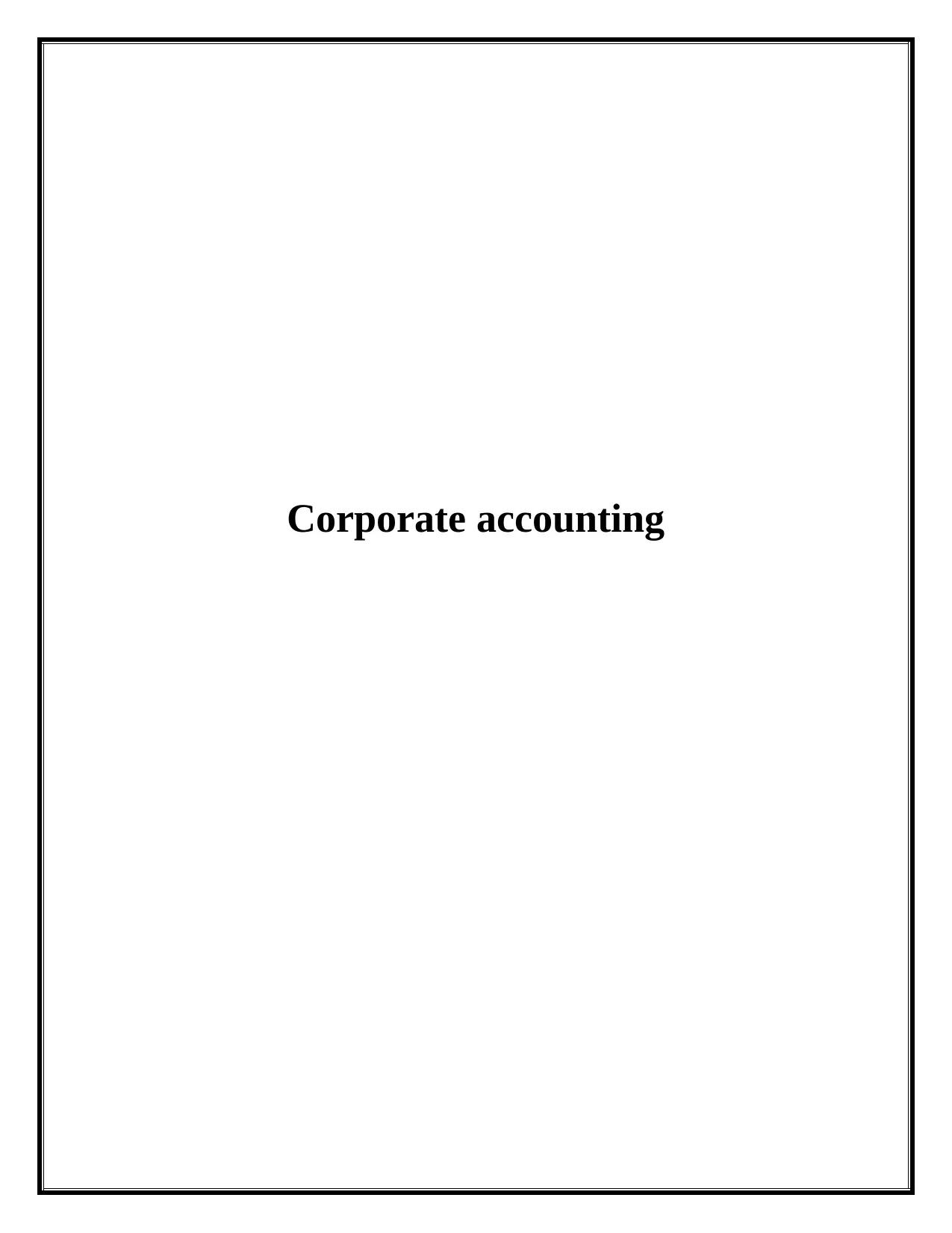
Corporate accounting
Paraphrase This Document
Need a fresh take? Get an instant paraphrase of this document with our AI Paraphraser
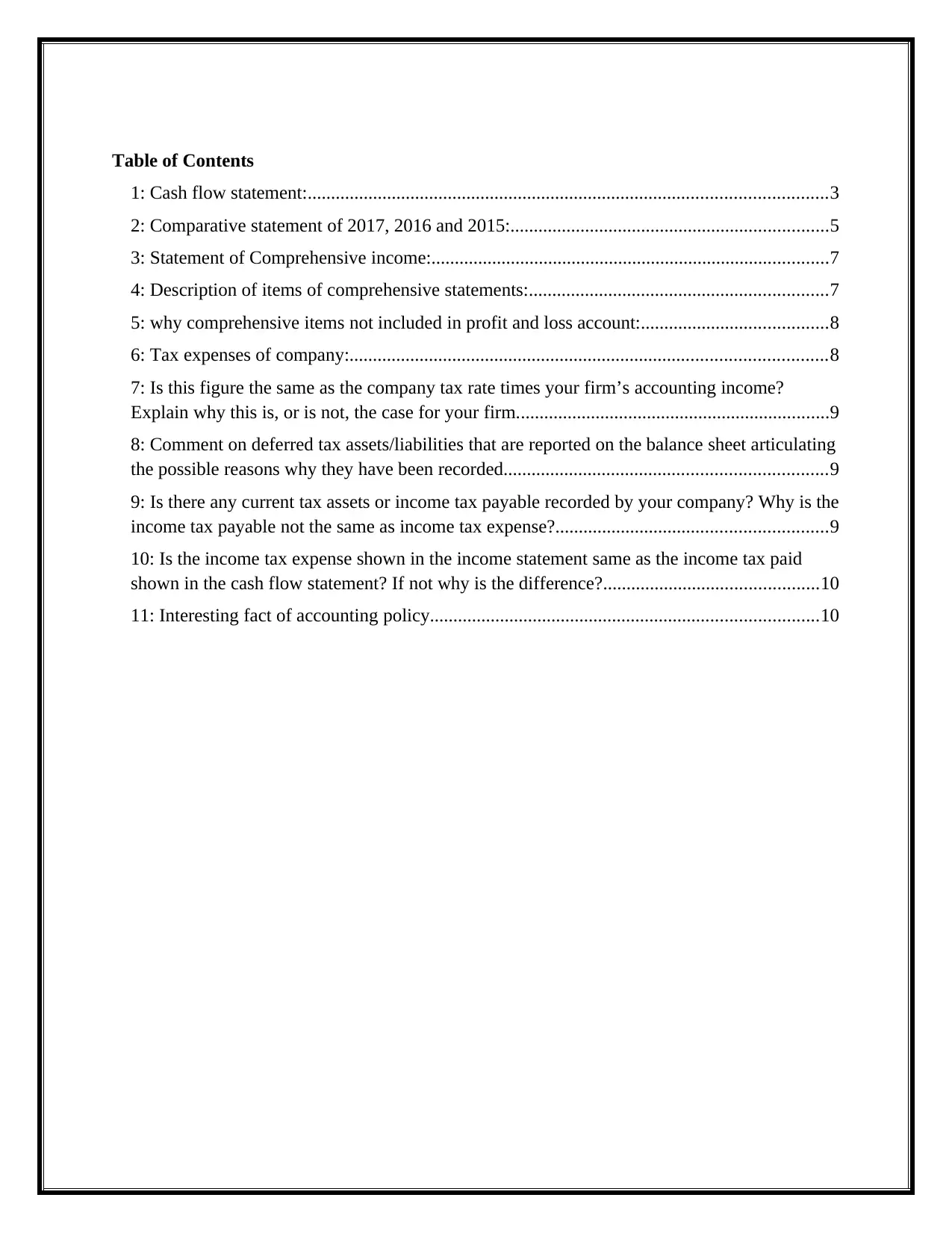
Table of Contents
1: Cash flow statement:...............................................................................................................3
2: Comparative statement of 2017, 2016 and 2015:....................................................................5
3: Statement of Comprehensive income:.....................................................................................7
4: Description of items of comprehensive statements:................................................................7
5: why comprehensive items not included in profit and loss account:........................................8
6: Tax expenses of company:......................................................................................................8
7: Is this figure the same as the company tax rate times your firm’s accounting income?
Explain why this is, or is not, the case for your firm...................................................................9
8: Comment on deferred tax assets/liabilities that are reported on the balance sheet articulating
the possible reasons why they have been recorded.....................................................................9
9: Is there any current tax assets or income tax payable recorded by your company? Why is the
income tax payable not the same as income tax expense?..........................................................9
10: Is the income tax expense shown in the income statement same as the income tax paid
shown in the cash flow statement? If not why is the difference?..............................................10
11: Interesting fact of accounting policy...................................................................................10
1: Cash flow statement:...............................................................................................................3
2: Comparative statement of 2017, 2016 and 2015:....................................................................5
3: Statement of Comprehensive income:.....................................................................................7
4: Description of items of comprehensive statements:................................................................7
5: why comprehensive items not included in profit and loss account:........................................8
6: Tax expenses of company:......................................................................................................8
7: Is this figure the same as the company tax rate times your firm’s accounting income?
Explain why this is, or is not, the case for your firm...................................................................9
8: Comment on deferred tax assets/liabilities that are reported on the balance sheet articulating
the possible reasons why they have been recorded.....................................................................9
9: Is there any current tax assets or income tax payable recorded by your company? Why is the
income tax payable not the same as income tax expense?..........................................................9
10: Is the income tax expense shown in the income statement same as the income tax paid
shown in the cash flow statement? If not why is the difference?..............................................10
11: Interesting fact of accounting policy...................................................................................10
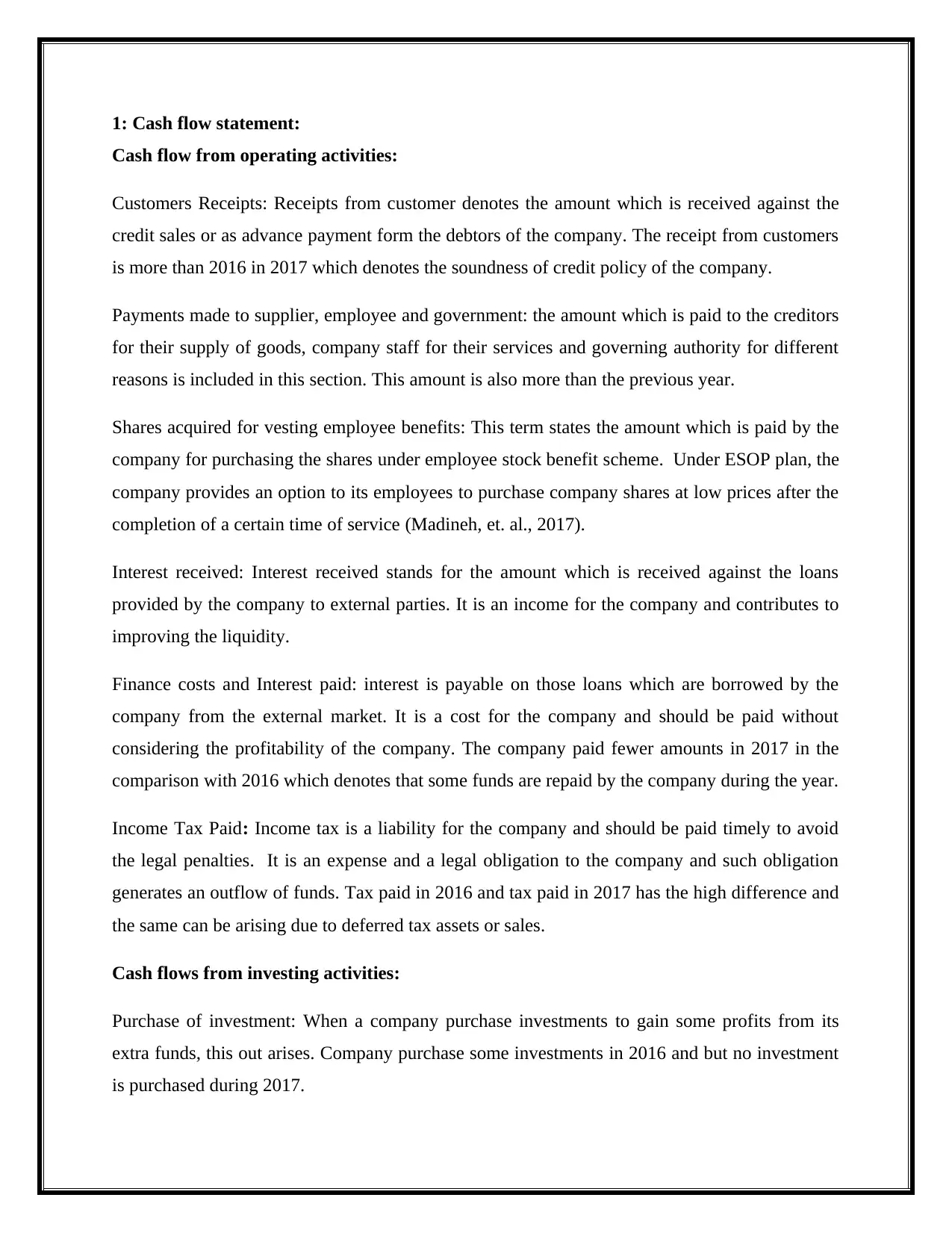
1: Cash flow statement:
Cash flow from operating activities:
Customers Receipts: Receipts from customer denotes the amount which is received against the
credit sales or as advance payment form the debtors of the company. The receipt from customers
is more than 2016 in 2017 which denotes the soundness of credit policy of the company.
Payments made to supplier, employee and government: the amount which is paid to the creditors
for their supply of goods, company staff for their services and governing authority for different
reasons is included in this section. This amount is also more than the previous year.
Shares acquired for vesting employee benefits: This term states the amount which is paid by the
company for purchasing the shares under employee stock benefit scheme. Under ESOP plan, the
company provides an option to its employees to purchase company shares at low prices after the
completion of a certain time of service (Madineh, et. al., 2017).
Interest received: Interest received stands for the amount which is received against the loans
provided by the company to external parties. It is an income for the company and contributes to
improving the liquidity.
Finance costs and Interest paid: interest is payable on those loans which are borrowed by the
company from the external market. It is a cost for the company and should be paid without
considering the profitability of the company. The company paid fewer amounts in 2017 in the
comparison with 2016 which denotes that some funds are repaid by the company during the year.
Income Tax Paid: Income tax is a liability for the company and should be paid timely to avoid
the legal penalties. It is an expense and a legal obligation to the company and such obligation
generates an outflow of funds. Tax paid in 2016 and tax paid in 2017 has the high difference and
the same can be arising due to deferred tax assets or sales.
Cash flows from investing activities:
Purchase of investment: When a company purchase investments to gain some profits from its
extra funds, this out arises. Company purchase some investments in 2016 and but no investment
is purchased during 2017.
Cash flow from operating activities:
Customers Receipts: Receipts from customer denotes the amount which is received against the
credit sales or as advance payment form the debtors of the company. The receipt from customers
is more than 2016 in 2017 which denotes the soundness of credit policy of the company.
Payments made to supplier, employee and government: the amount which is paid to the creditors
for their supply of goods, company staff for their services and governing authority for different
reasons is included in this section. This amount is also more than the previous year.
Shares acquired for vesting employee benefits: This term states the amount which is paid by the
company for purchasing the shares under employee stock benefit scheme. Under ESOP plan, the
company provides an option to its employees to purchase company shares at low prices after the
completion of a certain time of service (Madineh, et. al., 2017).
Interest received: Interest received stands for the amount which is received against the loans
provided by the company to external parties. It is an income for the company and contributes to
improving the liquidity.
Finance costs and Interest paid: interest is payable on those loans which are borrowed by the
company from the external market. It is a cost for the company and should be paid without
considering the profitability of the company. The company paid fewer amounts in 2017 in the
comparison with 2016 which denotes that some funds are repaid by the company during the year.
Income Tax Paid: Income tax is a liability for the company and should be paid timely to avoid
the legal penalties. It is an expense and a legal obligation to the company and such obligation
generates an outflow of funds. Tax paid in 2016 and tax paid in 2017 has the high difference and
the same can be arising due to deferred tax assets or sales.
Cash flows from investing activities:
Purchase of investment: When a company purchase investments to gain some profits from its
extra funds, this out arises. Company purchase some investments in 2016 and but no investment
is purchased during 2017.
⊘ This is a preview!⊘
Do you want full access?
Subscribe today to unlock all pages.

Trusted by 1+ million students worldwide

Purchases of businesses: This term stands for the amount which paid the company for purchasing
a business. This can be done through the merger, amalgamation or business purchase
combination. The amount to acquire the business, which is paid by the company as a cash
payment is included here.
Purchases of property, Equipment and plant: This term represents the amount which is paid by
the company to acquire the fix assets. Equipment and plant are purchased to support the
production process and property can be purchased for investment and business use purpose.
Major payment cyclical maintenance: this term marks the amount which is paid for the timely
maintenance of assets and plants. It is an expense for the company and generates outflow of
funds (Gazzola and Amelio, 2014).
Purchases of intangibles: intangibles are those assets which are used in business but they do not
have any physical existence and the amount paid by those assets is included in this term.
Net proceeds from the sale of equipment property and plant: the amount which is received
against the sales of old property and plant is denoted by this term. Some assets which are not
more useful for the business can be solved by the company and the amount which is received for
the same is included here.
Cash flow financing activities
Proceeds from borrowings: This figure marks that amount which is borrowed by the company
from market to finance its business activities. It is a liability which should be paid along with
interest. Fund borrowing is normal business activity and generates fix costs for the business.
Repayments of borrowings: this term denotes the amount which is repaid by the company to its
lenders. It is also noted that the amount which is borrowed by the company is same as the
amount paid and it proves that the borrowing was a short-term borrowing (Madineh, et. al.,
2017).
Payment for share buyback: the amount which is paid by the company to purchase its own shares
is reported here.
a business. This can be done through the merger, amalgamation or business purchase
combination. The amount to acquire the business, which is paid by the company as a cash
payment is included here.
Purchases of property, Equipment and plant: This term represents the amount which is paid by
the company to acquire the fix assets. Equipment and plant are purchased to support the
production process and property can be purchased for investment and business use purpose.
Major payment cyclical maintenance: this term marks the amount which is paid for the timely
maintenance of assets and plants. It is an expense for the company and generates outflow of
funds (Gazzola and Amelio, 2014).
Purchases of intangibles: intangibles are those assets which are used in business but they do not
have any physical existence and the amount paid by those assets is included in this term.
Net proceeds from the sale of equipment property and plant: the amount which is received
against the sales of old property and plant is denoted by this term. Some assets which are not
more useful for the business can be solved by the company and the amount which is received for
the same is included here.
Cash flow financing activities
Proceeds from borrowings: This figure marks that amount which is borrowed by the company
from market to finance its business activities. It is a liability which should be paid along with
interest. Fund borrowing is normal business activity and generates fix costs for the business.
Repayments of borrowings: this term denotes the amount which is repaid by the company to its
lenders. It is also noted that the amount which is borrowed by the company is same as the
amount paid and it proves that the borrowing was a short-term borrowing (Madineh, et. al.,
2017).
Payment for share buyback: the amount which is paid by the company to purchase its own shares
is reported here.
Paraphrase This Document
Need a fresh take? Get an instant paraphrase of this document with our AI Paraphraser
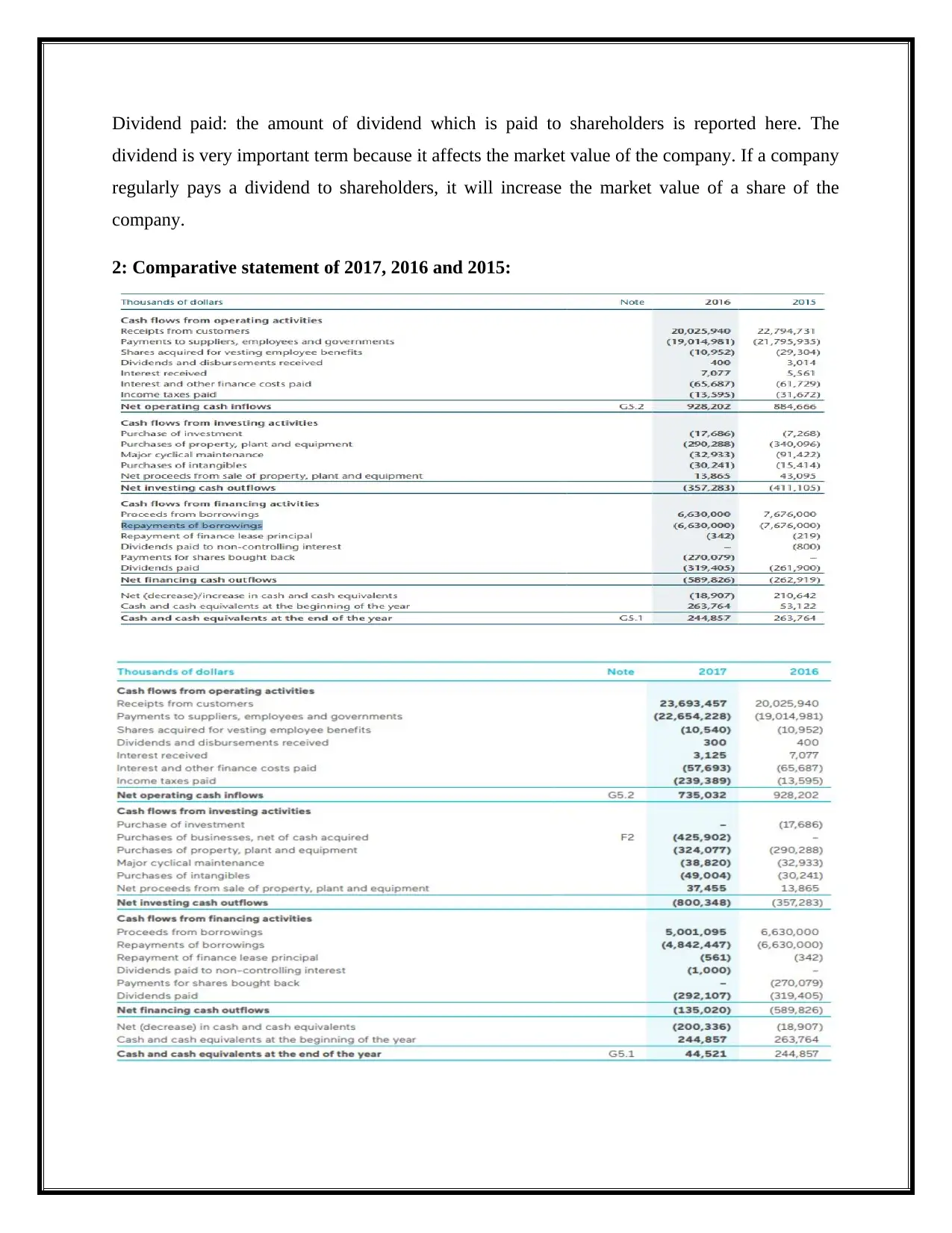
Dividend paid: the amount of dividend which is paid to shareholders is reported here. The
dividend is very important term because it affects the market value of the company. If a company
regularly pays a dividend to shareholders, it will increase the market value of a share of the
company.
2: Comparative statement of 2017, 2016 and 2015:
dividend is very important term because it affects the market value of the company. If a company
regularly pays a dividend to shareholders, it will increase the market value of a share of the
company.
2: Comparative statement of 2017, 2016 and 2015:

Particulars 2015 2016 2017
Change
2015-2016
change
2016-2017
Change
2015-2017
Cash flow from
operational activity 884,666 928,202 735,032 43,536 -193,170 -149,634
Cash flow from
investment activity -411,105 -357,283 -800,348 53,822 -443,065 -389,243
Cash flow from
finance activity -262,919 -589,826 -135,020 -326,907 454,806 127,899
3: Statement of Comprehensive income:
Change
2015-2016
change
2016-2017
Change
2015-2017
Cash flow from
operational activity 884,666 928,202 735,032 43,536 -193,170 -149,634
Cash flow from
investment activity -411,105 -357,283 -800,348 53,822 -443,065 -389,243
Cash flow from
finance activity -262,919 -589,826 -135,020 -326,907 454,806 127,899
3: Statement of Comprehensive income:
⊘ This is a preview!⊘
Do you want full access?
Subscribe today to unlock all pages.

Trusted by 1+ million students worldwide
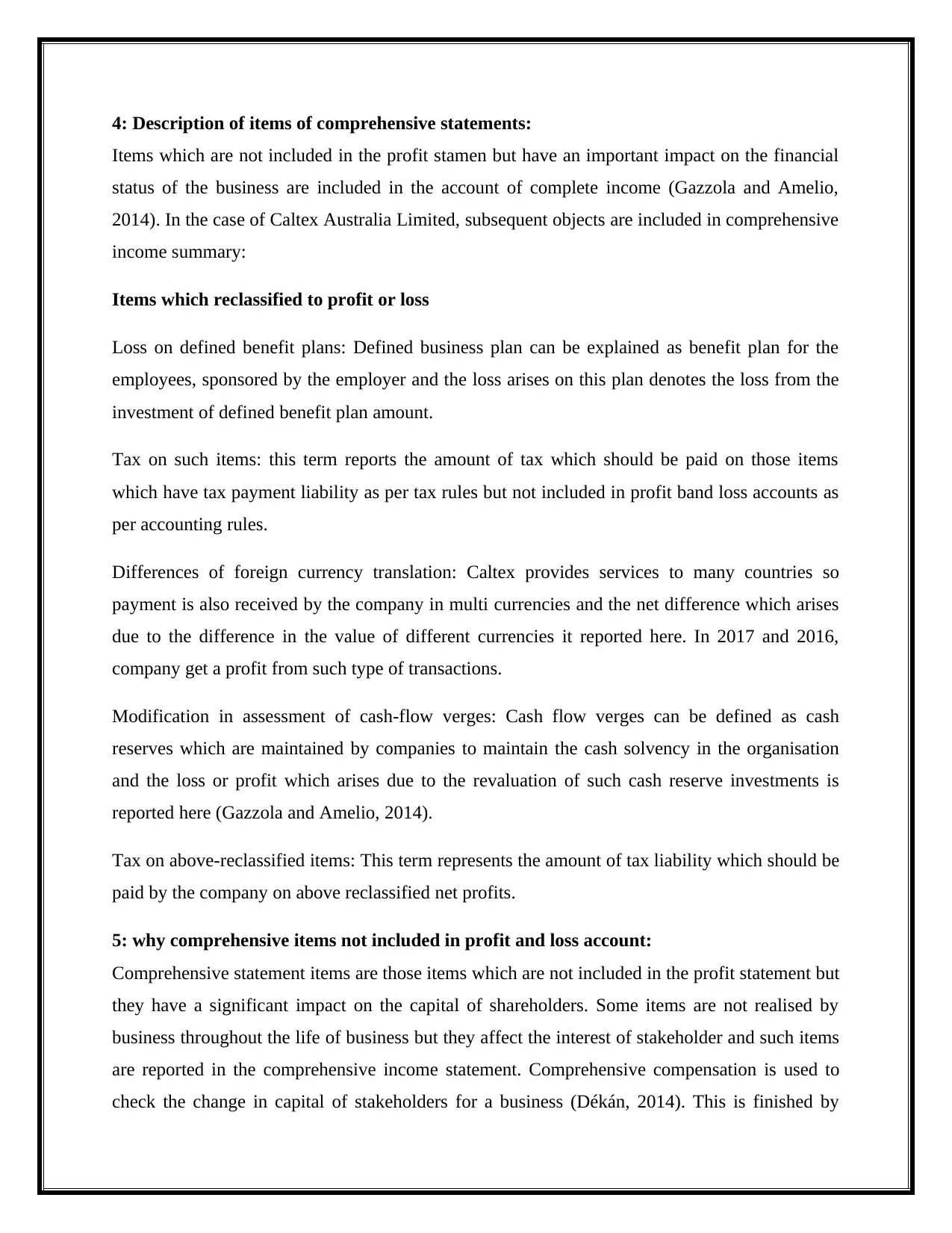
4: Description of items of comprehensive statements:
Items which are not included in the profit stamen but have an important impact on the financial
status of the business are included in the account of complete income (Gazzola and Amelio,
2014). In the case of Caltex Australia Limited, subsequent objects are included in comprehensive
income summary:
Items which reclassified to profit or loss
Loss on defined benefit plans: Defined business plan can be explained as benefit plan for the
employees, sponsored by the employer and the loss arises on this plan denotes the loss from the
investment of defined benefit plan amount.
Tax on such items: this term reports the amount of tax which should be paid on those items
which have tax payment liability as per tax rules but not included in profit band loss accounts as
per accounting rules.
Differences of foreign currency translation: Caltex provides services to many countries so
payment is also received by the company in multi currencies and the net difference which arises
due to the difference in the value of different currencies it reported here. In 2017 and 2016,
company get a profit from such type of transactions.
Modification in assessment of cash-flow verges: Cash flow verges can be defined as cash
reserves which are maintained by companies to maintain the cash solvency in the organisation
and the loss or profit which arises due to the revaluation of such cash reserve investments is
reported here (Gazzola and Amelio, 2014).
Tax on above-reclassified items: This term represents the amount of tax liability which should be
paid by the company on above reclassified net profits.
5: why comprehensive items not included in profit and loss account:
Comprehensive statement items are those items which are not included in the profit statement but
they have a significant impact on the capital of shareholders. Some items are not realised by
business throughout the life of business but they affect the interest of stakeholder and such items
are reported in the comprehensive income statement. Comprehensive compensation is used to
check the change in capital of stakeholders for a business (Dékán, 2014). This is finished by
Items which are not included in the profit stamen but have an important impact on the financial
status of the business are included in the account of complete income (Gazzola and Amelio,
2014). In the case of Caltex Australia Limited, subsequent objects are included in comprehensive
income summary:
Items which reclassified to profit or loss
Loss on defined benefit plans: Defined business plan can be explained as benefit plan for the
employees, sponsored by the employer and the loss arises on this plan denotes the loss from the
investment of defined benefit plan amount.
Tax on such items: this term reports the amount of tax which should be paid on those items
which have tax payment liability as per tax rules but not included in profit band loss accounts as
per accounting rules.
Differences of foreign currency translation: Caltex provides services to many countries so
payment is also received by the company in multi currencies and the net difference which arises
due to the difference in the value of different currencies it reported here. In 2017 and 2016,
company get a profit from such type of transactions.
Modification in assessment of cash-flow verges: Cash flow verges can be defined as cash
reserves which are maintained by companies to maintain the cash solvency in the organisation
and the loss or profit which arises due to the revaluation of such cash reserve investments is
reported here (Gazzola and Amelio, 2014).
Tax on above-reclassified items: This term represents the amount of tax liability which should be
paid by the company on above reclassified net profits.
5: why comprehensive items not included in profit and loss account:
Comprehensive statement items are those items which are not included in the profit statement but
they have a significant impact on the capital of shareholders. Some items are not realised by
business throughout the life of business but they affect the interest of stakeholder and such items
are reported in the comprehensive income statement. Comprehensive compensation is used to
check the change in capital of stakeholders for a business (Dékán, 2014). This is finished by
Paraphrase This Document
Need a fresh take? Get an instant paraphrase of this document with our AI Paraphraser
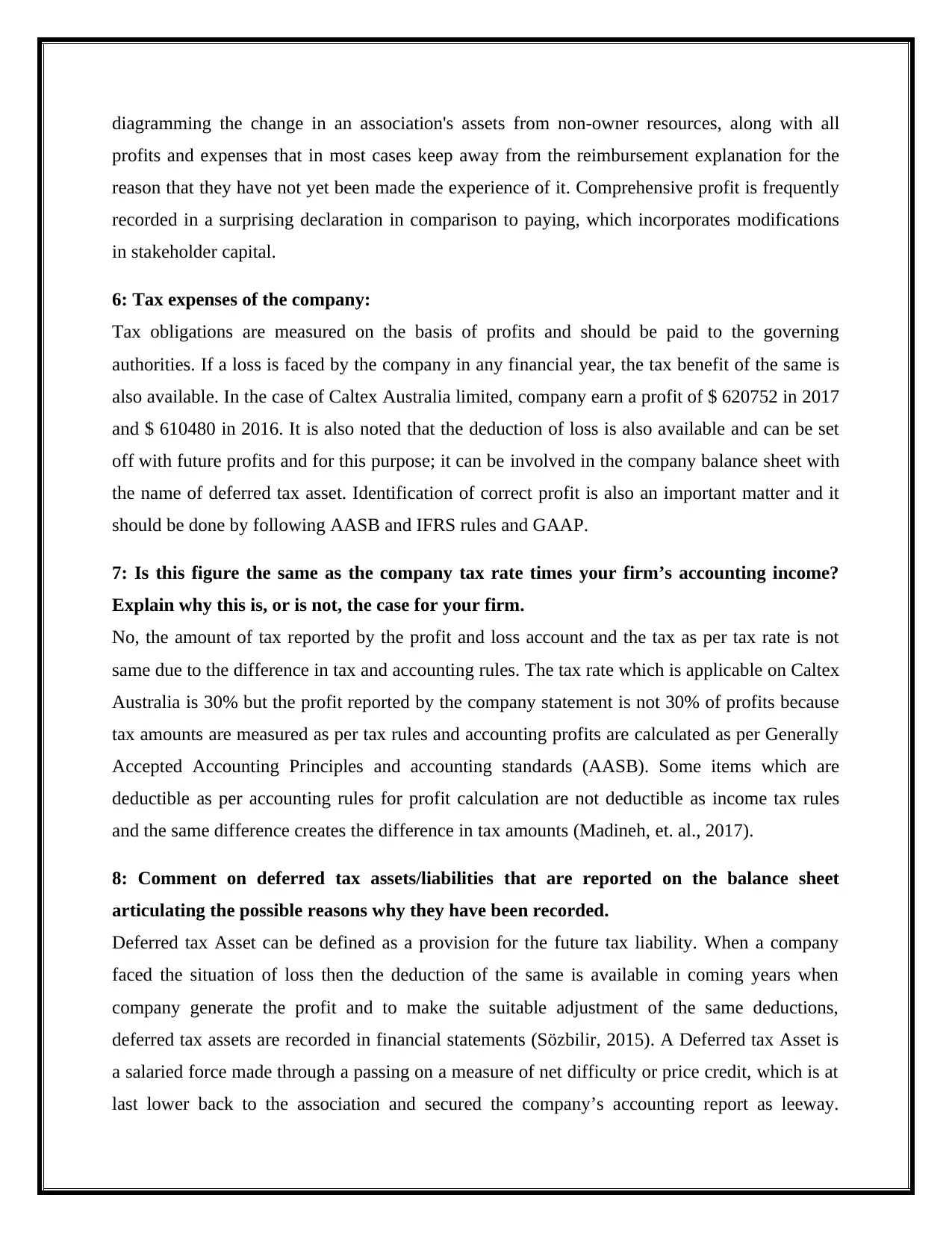
diagramming the change in an association's assets from non-owner resources, along with all
profits and expenses that in most cases keep away from the reimbursement explanation for the
reason that they have not yet been made the experience of it. Comprehensive profit is frequently
recorded in a surprising declaration in comparison to paying, which incorporates modifications
in stakeholder capital.
6: Tax expenses of the company:
Tax obligations are measured on the basis of profits and should be paid to the governing
authorities. If a loss is faced by the company in any financial year, the tax benefit of the same is
also available. In the case of Caltex Australia limited, company earn a profit of $ 620752 in 2017
and $ 610480 in 2016. It is also noted that the deduction of loss is also available and can be set
off with future profits and for this purpose; it can be involved in the company balance sheet with
the name of deferred tax asset. Identification of correct profit is also an important matter and it
should be done by following AASB and IFRS rules and GAAP.
7: Is this figure the same as the company tax rate times your firm’s accounting income?
Explain why this is, or is not, the case for your firm.
No, the amount of tax reported by the profit and loss account and the tax as per tax rate is not
same due to the difference in tax and accounting rules. The tax rate which is applicable on Caltex
Australia is 30% but the profit reported by the company statement is not 30% of profits because
tax amounts are measured as per tax rules and accounting profits are calculated as per Generally
Accepted Accounting Principles and accounting standards (AASB). Some items which are
deductible as per accounting rules for profit calculation are not deductible as income tax rules
and the same difference creates the difference in tax amounts (Madineh, et. al., 2017).
8: Comment on deferred tax assets/liabilities that are reported on the balance sheet
articulating the possible reasons why they have been recorded.
Deferred tax Asset can be defined as a provision for the future tax liability. When a company
faced the situation of loss then the deduction of the same is available in coming years when
company generate the profit and to make the suitable adjustment of the same deductions,
deferred tax assets are recorded in financial statements (Sözbilir, 2015). A Deferred tax Asset is
a salaried force made through a passing on a measure of net difficulty or price credit, which is at
last lower back to the association and secured the company’s accounting report as leeway.
profits and expenses that in most cases keep away from the reimbursement explanation for the
reason that they have not yet been made the experience of it. Comprehensive profit is frequently
recorded in a surprising declaration in comparison to paying, which incorporates modifications
in stakeholder capital.
6: Tax expenses of the company:
Tax obligations are measured on the basis of profits and should be paid to the governing
authorities. If a loss is faced by the company in any financial year, the tax benefit of the same is
also available. In the case of Caltex Australia limited, company earn a profit of $ 620752 in 2017
and $ 610480 in 2016. It is also noted that the deduction of loss is also available and can be set
off with future profits and for this purpose; it can be involved in the company balance sheet with
the name of deferred tax asset. Identification of correct profit is also an important matter and it
should be done by following AASB and IFRS rules and GAAP.
7: Is this figure the same as the company tax rate times your firm’s accounting income?
Explain why this is, or is not, the case for your firm.
No, the amount of tax reported by the profit and loss account and the tax as per tax rate is not
same due to the difference in tax and accounting rules. The tax rate which is applicable on Caltex
Australia is 30% but the profit reported by the company statement is not 30% of profits because
tax amounts are measured as per tax rules and accounting profits are calculated as per Generally
Accepted Accounting Principles and accounting standards (AASB). Some items which are
deductible as per accounting rules for profit calculation are not deductible as income tax rules
and the same difference creates the difference in tax amounts (Madineh, et. al., 2017).
8: Comment on deferred tax assets/liabilities that are reported on the balance sheet
articulating the possible reasons why they have been recorded.
Deferred tax Asset can be defined as a provision for the future tax liability. When a company
faced the situation of loss then the deduction of the same is available in coming years when
company generate the profit and to make the suitable adjustment of the same deductions,
deferred tax assets are recorded in financial statements (Sözbilir, 2015). A Deferred tax Asset is
a salaried force made through a passing on a measure of net difficulty or price credit, which is at
last lower back to the association and secured the company’s accounting report as leeway.
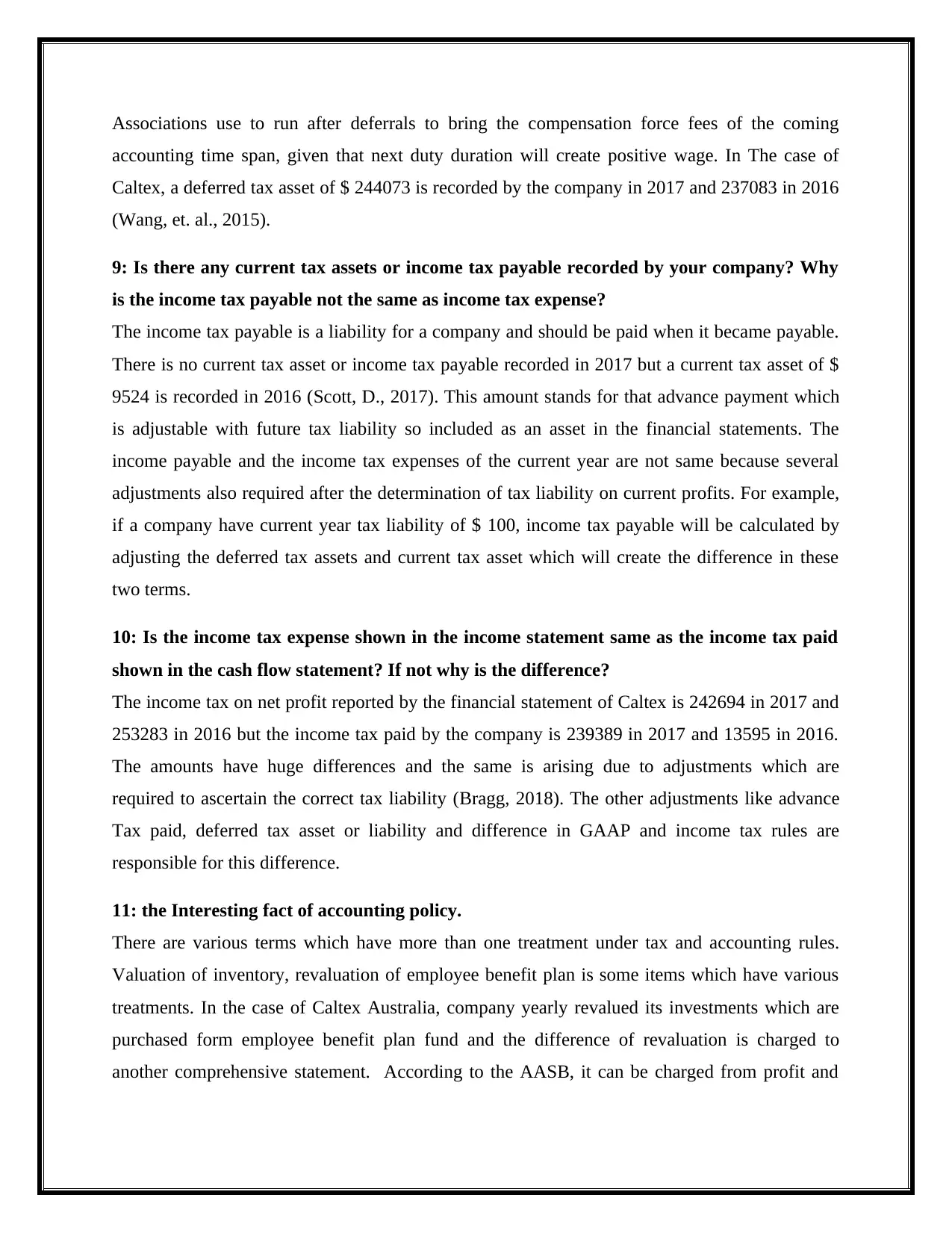
Associations use to run after deferrals to bring the compensation force fees of the coming
accounting time span, given that next duty duration will create positive wage. In The case of
Caltex, a deferred tax asset of $ 244073 is recorded by the company in 2017 and 237083 in 2016
(Wang, et. al., 2015).
9: Is there any current tax assets or income tax payable recorded by your company? Why
is the income tax payable not the same as income tax expense?
The income tax payable is a liability for a company and should be paid when it became payable.
There is no current tax asset or income tax payable recorded in 2017 but a current tax asset of $
9524 is recorded in 2016 (Scott, D., 2017). This amount stands for that advance payment which
is adjustable with future tax liability so included as an asset in the financial statements. The
income payable and the income tax expenses of the current year are not same because several
adjustments also required after the determination of tax liability on current profits. For example,
if a company have current year tax liability of $ 100, income tax payable will be calculated by
adjusting the deferred tax assets and current tax asset which will create the difference in these
two terms.
10: Is the income tax expense shown in the income statement same as the income tax paid
shown in the cash flow statement? If not why is the difference?
The income tax on net profit reported by the financial statement of Caltex is 242694 in 2017 and
253283 in 2016 but the income tax paid by the company is 239389 in 2017 and 13595 in 2016.
The amounts have huge differences and the same is arising due to adjustments which are
required to ascertain the correct tax liability (Bragg, 2018). The other adjustments like advance
Tax paid, deferred tax asset or liability and difference in GAAP and income tax rules are
responsible for this difference.
11: the Interesting fact of accounting policy.
There are various terms which have more than one treatment under tax and accounting rules.
Valuation of inventory, revaluation of employee benefit plan is some items which have various
treatments. In the case of Caltex Australia, company yearly revalued its investments which are
purchased form employee benefit plan fund and the difference of revaluation is charged to
another comprehensive statement. According to the AASB, it can be charged from profit and
accounting time span, given that next duty duration will create positive wage. In The case of
Caltex, a deferred tax asset of $ 244073 is recorded by the company in 2017 and 237083 in 2016
(Wang, et. al., 2015).
9: Is there any current tax assets or income tax payable recorded by your company? Why
is the income tax payable not the same as income tax expense?
The income tax payable is a liability for a company and should be paid when it became payable.
There is no current tax asset or income tax payable recorded in 2017 but a current tax asset of $
9524 is recorded in 2016 (Scott, D., 2017). This amount stands for that advance payment which
is adjustable with future tax liability so included as an asset in the financial statements. The
income payable and the income tax expenses of the current year are not same because several
adjustments also required after the determination of tax liability on current profits. For example,
if a company have current year tax liability of $ 100, income tax payable will be calculated by
adjusting the deferred tax assets and current tax asset which will create the difference in these
two terms.
10: Is the income tax expense shown in the income statement same as the income tax paid
shown in the cash flow statement? If not why is the difference?
The income tax on net profit reported by the financial statement of Caltex is 242694 in 2017 and
253283 in 2016 but the income tax paid by the company is 239389 in 2017 and 13595 in 2016.
The amounts have huge differences and the same is arising due to adjustments which are
required to ascertain the correct tax liability (Bragg, 2018). The other adjustments like advance
Tax paid, deferred tax asset or liability and difference in GAAP and income tax rules are
responsible for this difference.
11: the Interesting fact of accounting policy.
There are various terms which have more than one treatment under tax and accounting rules.
Valuation of inventory, revaluation of employee benefit plan is some items which have various
treatments. In the case of Caltex Australia, company yearly revalued its investments which are
purchased form employee benefit plan fund and the difference of revaluation is charged to
another comprehensive statement. According to the AASB, it can be charged from profit and
⊘ This is a preview!⊘
Do you want full access?
Subscribe today to unlock all pages.

Trusted by 1+ million students worldwide
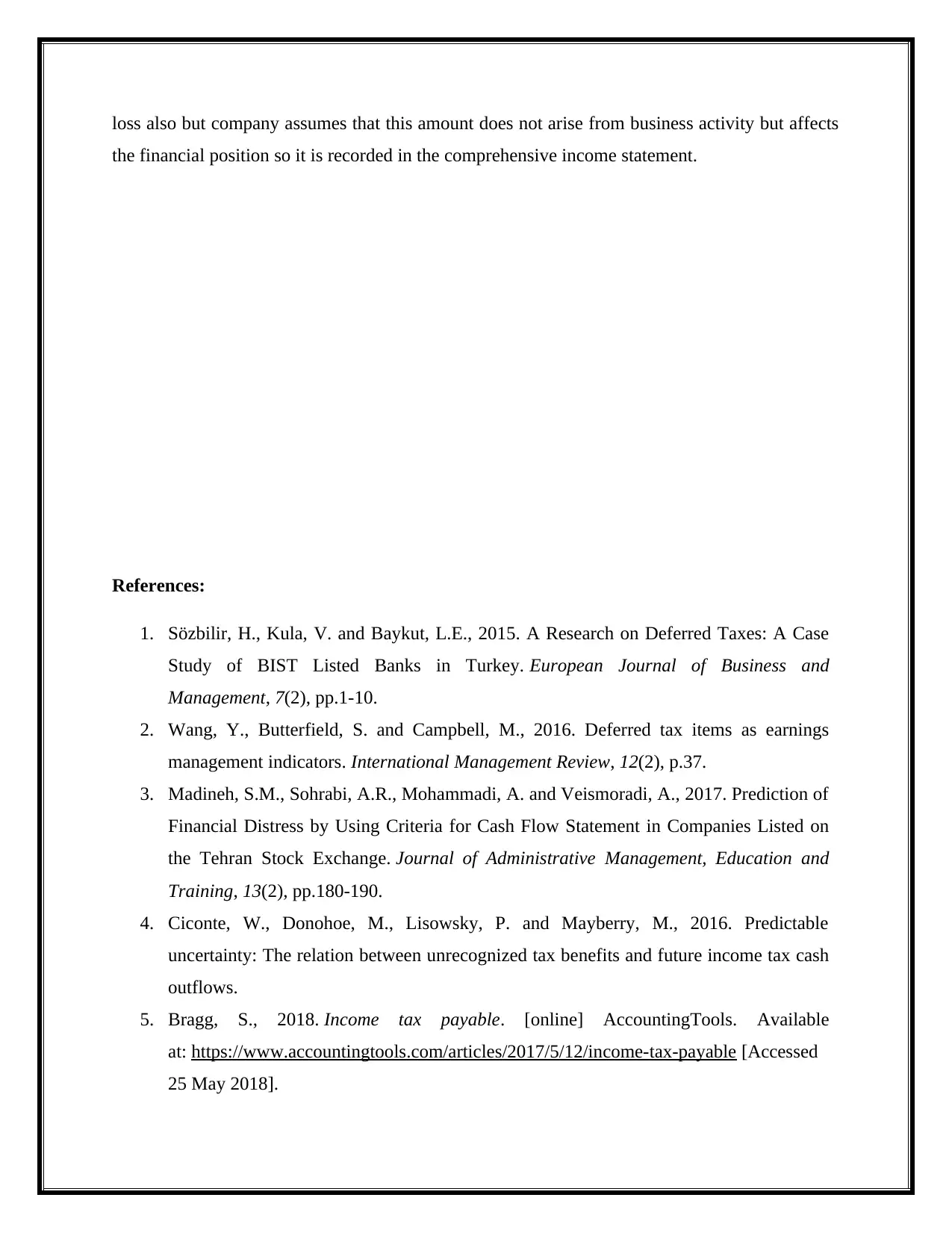
loss also but company assumes that this amount does not arise from business activity but affects
the financial position so it is recorded in the comprehensive income statement.
References:
1. Sözbilir, H., Kula, V. and Baykut, L.E., 2015. A Research on Deferred Taxes: A Case
Study of BIST Listed Banks in Turkey. European Journal of Business and
Management, 7(2), pp.1-10.
2. Wang, Y., Butterfield, S. and Campbell, M., 2016. Deferred tax items as earnings
management indicators. International Management Review, 12(2), p.37.
3. Madineh, S.M., Sohrabi, A.R., Mohammadi, A. and Veismoradi, A., 2017. Prediction of
Financial Distress by Using Criteria for Cash Flow Statement in Companies Listed on
the Tehran Stock Exchange. Journal of Administrative Management, Education and
Training, 13(2), pp.180-190.
4. Ciconte, W., Donohoe, M., Lisowsky, P. and Mayberry, M., 2016. Predictable
uncertainty: The relation between unrecognized tax benefits and future income tax cash
outflows.
5. Bragg, S., 2018. Income tax payable. [online] AccountingTools. Available
at: https://www.accountingtools.com/articles/2017/5/12/income-tax-payable [Accessed
25 May 2018].
the financial position so it is recorded in the comprehensive income statement.
References:
1. Sözbilir, H., Kula, V. and Baykut, L.E., 2015. A Research on Deferred Taxes: A Case
Study of BIST Listed Banks in Turkey. European Journal of Business and
Management, 7(2), pp.1-10.
2. Wang, Y., Butterfield, S. and Campbell, M., 2016. Deferred tax items as earnings
management indicators. International Management Review, 12(2), p.37.
3. Madineh, S.M., Sohrabi, A.R., Mohammadi, A. and Veismoradi, A., 2017. Prediction of
Financial Distress by Using Criteria for Cash Flow Statement in Companies Listed on
the Tehran Stock Exchange. Journal of Administrative Management, Education and
Training, 13(2), pp.180-190.
4. Ciconte, W., Donohoe, M., Lisowsky, P. and Mayberry, M., 2016. Predictable
uncertainty: The relation between unrecognized tax benefits and future income tax cash
outflows.
5. Bragg, S., 2018. Income tax payable. [online] AccountingTools. Available
at: https://www.accountingtools.com/articles/2017/5/12/income-tax-payable [Accessed
25 May 2018].
Paraphrase This Document
Need a fresh take? Get an instant paraphrase of this document with our AI Paraphraser
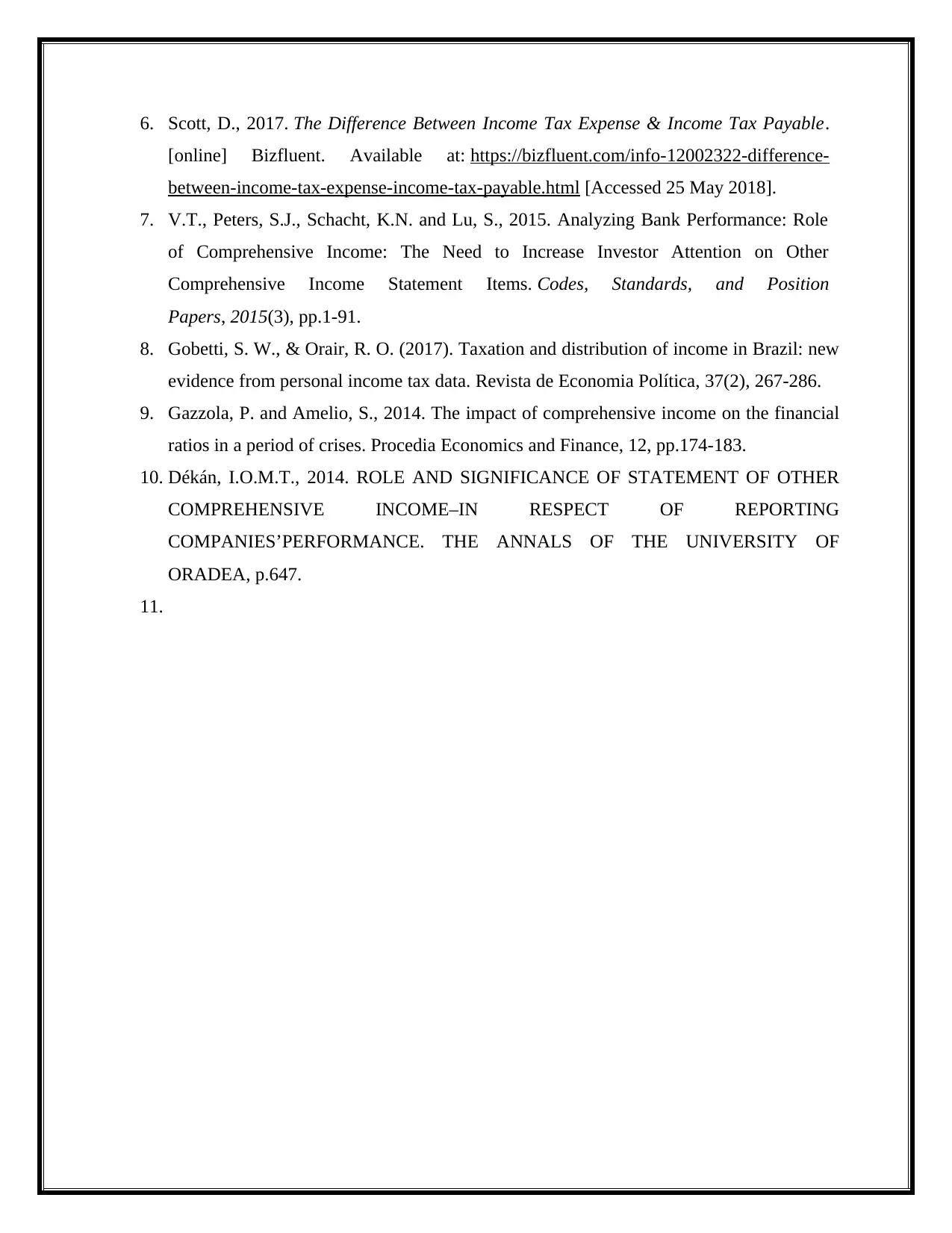
6. Scott, D., 2017. The Difference Between Income Tax Expense & Income Tax Payable.
[online] Bizfluent. Available at: https://bizfluent.com/info-12002322-difference-
between-income-tax-expense-income-tax-payable.html [Accessed 25 May 2018].
7. V.T., Peters, S.J., Schacht, K.N. and Lu, S., 2015. Analyzing Bank Performance: Role
of Comprehensive Income: The Need to Increase Investor Attention on Other
Comprehensive Income Statement Items. Codes, Standards, and Position
Papers, 2015(3), pp.1-91.
8. Gobetti, S. W., & Orair, R. O. (2017). Taxation and distribution of income in Brazil: new
evidence from personal income tax data. Revista de Economia Política, 37(2), 267-286.
9. Gazzola, P. and Amelio, S., 2014. The impact of comprehensive income on the financial
ratios in a period of crises. Procedia Economics and Finance, 12, pp.174-183.
10. Dékán, I.O.M.T., 2014. ROLE AND SIGNIFICANCE OF STATEMENT OF OTHER
COMPREHENSIVE INCOME–IN RESPECT OF REPORTING
COMPANIES’PERFORMANCE. THE ANNALS OF THE UNIVERSITY OF
ORADEA, p.647.
11.
[online] Bizfluent. Available at: https://bizfluent.com/info-12002322-difference-
between-income-tax-expense-income-tax-payable.html [Accessed 25 May 2018].
7. V.T., Peters, S.J., Schacht, K.N. and Lu, S., 2015. Analyzing Bank Performance: Role
of Comprehensive Income: The Need to Increase Investor Attention on Other
Comprehensive Income Statement Items. Codes, Standards, and Position
Papers, 2015(3), pp.1-91.
8. Gobetti, S. W., & Orair, R. O. (2017). Taxation and distribution of income in Brazil: new
evidence from personal income tax data. Revista de Economia Política, 37(2), 267-286.
9. Gazzola, P. and Amelio, S., 2014. The impact of comprehensive income on the financial
ratios in a period of crises. Procedia Economics and Finance, 12, pp.174-183.
10. Dékán, I.O.M.T., 2014. ROLE AND SIGNIFICANCE OF STATEMENT OF OTHER
COMPREHENSIVE INCOME–IN RESPECT OF REPORTING
COMPANIES’PERFORMANCE. THE ANNALS OF THE UNIVERSITY OF
ORADEA, p.647.
11.
1 out of 11
Related Documents
Your All-in-One AI-Powered Toolkit for Academic Success.
+13062052269
info@desklib.com
Available 24*7 on WhatsApp / Email
![[object Object]](/_next/static/media/star-bottom.7253800d.svg)
Unlock your academic potential
Copyright © 2020–2025 A2Z Services. All Rights Reserved. Developed and managed by ZUCOL.





